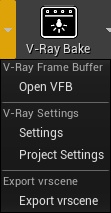This page provides details on the V-Ray for Unreal UI and how it is integrated into the Unreal interface.
Page Contents
Overview
The V-Ray for Unreal toolbar gives you access to all of the settings and options that are available with V-Ray.
V-Ray Toolbar
The V-Ray toolbar allows you to render using V-Ray’s Interactive renderer and access the V-Ray Settings tab
V-Ray Settings Tab
When you select the Settings button the V-Ray Settings tab will pop up. There you will have access to all options available with V-Ray for Unreal.
Common
- Lock Render Camera/View - When on, locks the render camera from Render from Camera/View .
- Render from Camera/View - Specifies the view that renders when you click the V-Ray render button.
- Lock Image Aspect - When enabled locks relation between X and Y of the image.
- Resolution - Sets the resolution output for rendering.
- Export VRScene - Enables the export of a vrscene file when you click the V-Ray render button. The vrscene file is saved in Installed_Directory_Unreal\UE_4.XX\Engine\Plugins\VRayForUnreal\Content.
- Compress - Compresses geometric information so that the resulting .vrscene file is smaller.
V-Ray
- Render Settings
- Time Limit(Minutes) - Specifies the maximum time (in minutes) for refining the image.
- Noise Limit - A threshold that determines when to stop refining a pixel. Higher values allow more noise in the image, while lower values try to reduce the noise. A value of 0.0 traces the entire image unconditionally.
- Sample Limit - Specifies the maximum samples per pixel for refining the image. V-Ray performs adaptive sampling on the image, trying to put more samples into areas that have more noise.
- Global Illumination
- GI Engine - Specifies the type of secondary engine. Note that Brute force is always used as primary engine.
- Brute Force
- GI Depth - The number of bounces for indirect illumination.
- Light Cache
- Subdivs -
- Sample Size -
- Retrace -
- Render Elements
- Denoiser -
- Environment -
Performance
- Utilization -
- Low GPU Thread Priority -
- Rays Per Pixel -
- Rays Bundle Size -
- Trace Depth -
- Textures -
- Mode -
- Max Size -
- Distributed Rendering



